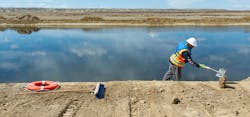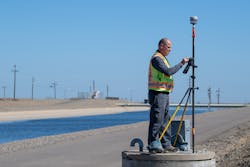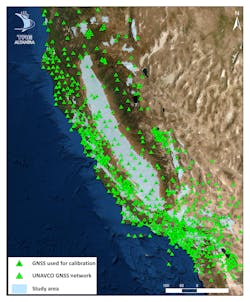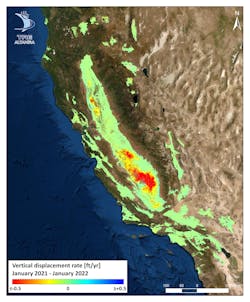When it comes to natural disasters, the sudden, swift devastation of landslides, mudslides, and sinkholes may get all the attention — but natural resource scientists can attest that it’s the slow sinking of the ground surface that is just as real a danger.
“Subsidence often gets neglected because it is slow moving. You don’t recognize it until you start seeing damage,” says Michelle Sneed, a land subsidence specialist at the United States Geological Survey (USGS). “If the land is sinking the same regionally and you’re not on the coast, it generally is not a big problem. But if you’re on the coast, it’s a big problem. If you have long infrastructure that crosses areas that are sinking at different rates, it’s a big problem. If you have deep wells collapsing because of subsidence, that’s a problem.”
And the problem can be costly. Gone unchecked, all those little slumps of land deformation can eventually lead to costly repairs for water conveyance systems and damaged buildings, roads, bridges, and levees.
In California, the historically unmonitored and unregulated practice of groundwater pumping has led to declining groundwater levels in many basins across the state. These declining levels have also created pockets of displacement — some greater than 25 feet.
A 2014 land subsidence report produced by Luhdorff & Scalmanini Consulting Engineers stated that the city of San Jose sunk 14 feet between 1910-1995 and that subsidence from groundwater extraction throughout the valley translated to more than $756 million in damages.
“We know subsidence risk is more acute during droughts when more people rely on groundwater,” says Steven Springhorn, a program manager in the California Department of Water Resources (DWR) office of sustainable groundwater management. “And, given the intensifying drought conditions in California and our reliance on groundwater to provide drinking water and to support our ecosystems and industries, we’ve needed to advance sustainable groundwater management and pursue innovative tools to better manage and report subsidence throughout the state.”
One of those innovations is interferometric synthetic aperture radar (InSAR), a satellite-based data analysis technique that measures changes in the earth’s surface over time with millimeter precision. With its large area coverage, frequency, and precision, InSAR technology has not only enabled the DWR to develop its first-ever statewide subsidence monitoring system but it’s also bringing undetected subsidence to the surface, giving water managers a consistent source of ground-movement intelligence to help them improve groundwater management and bring stability to unstable ground.
The Missing Link
Although the ground surface can gradually lower from extracting groundwater, oil, natural gas, or mineral resources through pumping or mining activities, the USGS says that more than 80 percent of the subsidence in the U.S. is directly correlated to groundwater withdrawal. As large amounts of groundwater are withdrawn from certain types of soils such as fine-grained sediments, the sediments compact because the water is no longer filling the porous spaces. That compaction results in subsidence and can eliminate valuable aquifer storage space that can never be restored.
Although the DWR has adopted various technological tools and instruments such as GPS receivers, benchmark surveys, and extensometers to monitor subsidence across the state, the checks on ground movement have historically been site specific and sporadic. And that has made it difficult for managers to assess conditions across their 515 groundwater basins.
“Both extensometers and ground surveys give us accurate displacement measurements, but they only cover specific points,” says Springhorn. “And often, subsidence happens outside the localized measurements of GPS or extensometers, which doesn’t provide a holistic understanding of our groundwater system. To effectively manage this crucial resource, we needed a statewide monitoring system that would provide a routine, contiguous, and precise picture of subsidence across all of our basins.”
Through SGMA, more than 250 local groundwater sustainability agencies (GSAs) have been developed and, with support from DWR, they are responsible for conducting ongoing monitoring, collecting data, updating management plans, and carrying out projects and actions to assure sustainable groundwater conditions for future generations. SGMA and other programs gave DWR the platform and funding to create a statewide subsidence monitoring program. What was missing was the technology to do it.
Enter InSAR.
From Space to Subsurface
The InSAR technique involves examining a radar satellite’s synthetic aperture radar signal phases over the same geographic area at regular intervals. The differences in the signal phases are a direct result of changes in the distance between the target and satellite, due to the slightly different position of the point on the ground at each pass.
Two SAR images taken from the similar vantage point in space can then be combined to precisely measure changes in the distance between the satellite sensor and the ground surface as it uplifts or subsides. The satellite’s large area coverage, frequency, and precision are what make InSAR ideally suited for deformation mapping.
“InSAR captures hundreds of thousands of points and, for any measurement point, it can tell you with millimetric precision if it’s moving, the direction it’s moving — up or down or horizontally — and if the movement is accelerating,” says Giacomo Falorni, technical director of TRE ALTAMIRA (TREA), a CLS Group company with 20-years’ experience with InSAR services. “It can also provide that displacement detail over weeks, months, years, or decades.”
DWR had been tracking InSAR-based subsidence research conducted by USGS and NASA. Their results showed the technology’s success in detecting and mapping deformation. However, the studies had only been applied to specific regions for specific time periods; DWR needed to test the feasibility of using the technology statewide.
Targeting over 160 high- and medium-priority groundwater basins and surrounding areas dependent on groundwater, TREA processed 6,424 radar scenes over a three-year period from 2015-2018. Per DWR’s request, they used 231 existing GPS station measurements to calibrate the InSAR measurements. The survey company Towill used the remaining 600 GPS measurements to successfully validate the InSAR results.
That historical baseline, which covered 40,000 square miles, pinpointed widespread subsidence: some agricultural areas in the central valley showed more than 3 feet (90 cm) of deformation over three years.
Mapping Movement
Initially, DWR began releasing the monthly InSAR data annually. However, in April 2021, Gov. Gavin Newsom issued a Drought Proclamation that, in part, ordered the DWR to “accelerate updating the land subsidence data” it provides.
With that additional drought objective and related funding, the agency increased its InSAR reporting frequency to every three months to provide a more up-to-date view of subsidence conditions across the state during the ongoing drought.
“The annual satellite-based reports gave us a precise map of subsidence that’s accurate to within one inch,” says Springhorn. “But now we can see four times more frequently what the changing conditions are. That enables us to reach our goal of supplying timely, actionable subsidence information that local, state, and federal agencies can use to inform sustainable management and drought response.”
Every quarter, TREA acquires about 2,500 radar satellite scenes covering DWR’s monitoring area. They process and combine the captured scenes and then use sophisticated algorithms to determine and extract vertical movement. Following the same workflow as the first historical analysis, these vertical measurements are then calibrated and validated with GPS data to produce 100-meter-grid maps of subsidence points that are within DWR’s specified accuracy threshold of about 1 inch.
Each new map is connected to the previous months to provide a seamless, consistent record of displacement dating back to June 2015. TREA delivers to DWR both the vertical displacement point data and statewide raster maps, in monthly time stamps, for total subsidence — holistic views of deformation that they’ve never had before.
“Often subsidence occurs outside discrete ground-based monitoring stations,” says Springhorn. “InSAR gives us the broader view of what’s happening beyond our ground instrumentation. We can integrate that data with our ground GPS and extensometer monitoring to collectively provide a much more robust subsidence monitoring network than we had before. Now we can really see where subsidence is occurring, how fast it’s occurring, and detect new subsidence emerging in places that we haven’t seen it before.”
As part of its SGMA technical assistance role, DWR offers the InSAR-based subsidence data through customized portals. With the SGMA data viewer, technical users can see both vertical displacement point data and raster maps covering the whole state. Users can choose a specific location or zoom into an area and click on any point on the color-coded map. Annual subsidence measured for that point will appear. Clicking on the figure produces an interactive chart that plots the ground movement over time.
For example, one spot about 10 miles west of Visalia, in the San Joaquin Valley, subsided 5.3 feet between July 2015 and October 2021. These InSAR results can be layered with other datasets such as groundwater levels for further analysis and to better inform management decisions.
Targeting the general public, the California Groundwater Live dashboard offers an interactive map that can be filtered by county or specific location, groundwater basin, and water year to reveal subsidence levels ranging between 0.1 feet to more than 1 foot.
Users of the dashboard can choose subsidence measurements by water year across DWR’s entire monitoring area or narrow the search to a specific county like Merced. The user-friendly portal enables the public and local agencies to integrate the customized data directly into their subsidence mapping efforts.
“In our regulatory role, it was key for us to have consistent subsidence data to provide to GSAs and to receive from them to properly evaluate their groundwater plans,” says Brezing. “Now that GSAs have been able to easily access the InSAR data, they can not only see present subsidence: they have the historical context to identify patterns to help understand the underlying story of underground movement. It’s become a trusted data source that they’ve started to rely on for their management plans, which was an intended goal of ours.”
Colleagues in the California Geological Survey (CGS) have also benefited from DWR’s InSAR-based monitoring. In studying 2019’s subsidence results, DWR identified significant displacement caused from a 7.1 magnitude earthquake in a desert region in July 2019. The CGS corroborated the InSAR data as part of their post-earthquake analysis.
“Viewing the subsidence data on that spot, you can clearly see the pre-quake surface and in an instant the surface ruptures and you see it drop a foot,” says Springhorn. “Then it continues to drop another 0.6 feet and creates a new normal. Being able to see the geographic distribution of the displacement in both uplift and sinking, coupled with the history of movement, enabled our CGS colleagues to better understand the amount of land surface change from the earthquake. Equally important is it helps in California’s planning for future earthquakes.”
Now that DWR can more quickly analyze statewide subsidence, how much displacement are they finding? The short answer is: it varies. Subsidence in California is as fluid as the groundwater they manage.
However, there is cause to be optimistic. In February 2022, DWR announced that the pace of subsidence is slowing. Although the San Joaquin Valley and Sacramento Valley experienced the most subsidence in 2021 — 1.1 feet and 0.7 feet, respectively — fewer areas experienced higher rates of subsidence than at the end of the last drought in 2016.
InSAR alone isn’t a solution to stop subsidence. It can, however, be part of the solution. By bringing the invisible, underground movements to the surface, and providing an early-warning system for potential ground-movement hazards, managers can forge a path to proactive solutions for better groundwater management and surface stability. WW
About the Author: Mary Jo Wagner is a Vancouver-based freelance writer with over 25 years of experience covering geospatial technology. She can be reached at [email protected].
Published in WaterWorld magazine, November 2022.







